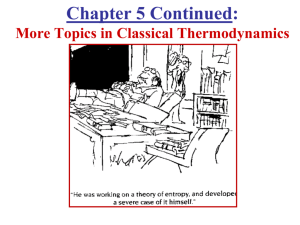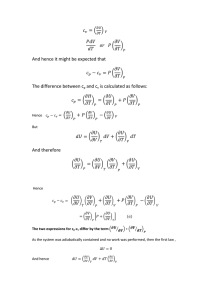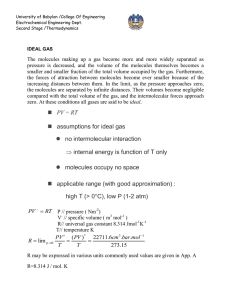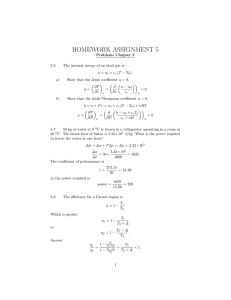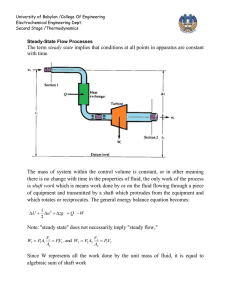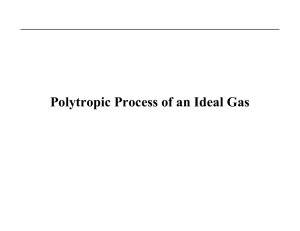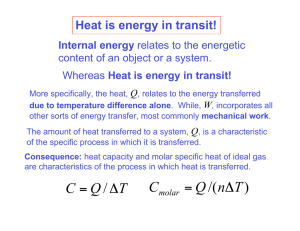Chapter 5 Continued: More Topics in Classical Thermodynamics
advertisement
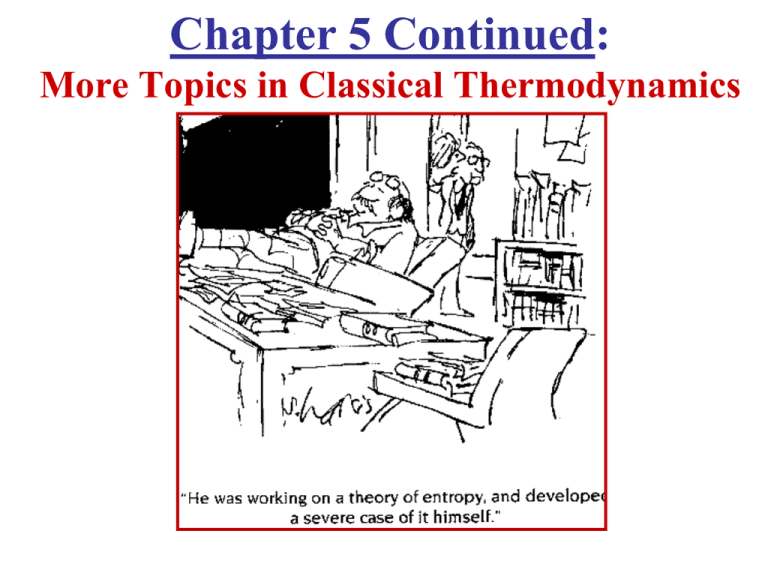
Chapter 5 Continued: More Topics in Classical Thermodynamics Einstein on Thermodynamics (1910) “A theory is the more impressive the greater the simplicity of its premises, and the more extended its area of applicability.” Einstein on Thermodynamics (1910) “A theory is the more impressive the greater the simplicity of its premises, and the more extended its area of applicability.” “Classical Thermodynamics… is the ONLY physical theory of universal content which I am convinced that, within the applicability of its basic concepts, WILL NEVER BE overthrown.” Eddington on Thermodynamics (1929) “If someone points out to you that your pet theory of the universe is in disagreement with Maxwell’s Equations, then so much the worse for Maxwell’s equations. Eddington on Thermodynamics (1929) “If someone points out to you that your pet theory of the universe is in disagreement with Maxwell’s Equations, then so much the worse for Maxwell’s equations. But if your theory is found to be against the 2nd Law of Thermodynamics - I can offer you no hope; there is nothing for it but to collapse in deepest humiliation!” Free Expansion ( The Joule Effect) • A type of Adiabatic Process is the FREE EXPANSION in which a gas is allowed to expand in volume adiabatically without doing any work. • It is adiabatic, so by definition, no heat flows in or out (Q = 0). Also no work is done because the gas does not move any other object, so W = 0. The 1st Law is: Q = ΔE + W Free Expansion ( The Joule Effect) • A type of Adiabatic Process is the FREE EXPANSION in which a gas is allowed to expand in volume adiabatically without doing any work. • It is adiabatic, so by definition, no heat flows in or out (Q = 0). Also no work is done because the gas does not move any other object, so W = 0. The 1st Law is: Q = ΔE + W • So, since Q = W = 0, the 1st Law says that ΔE = 0. • Thus this is a very peculiar type of expansion and In a Free Expansion, The Internal Energy of a Gas Does Not Change! Free Expansion Experiment • Experimentally, an Adiabatic Free Expansion of a gas into a vacuum cools a real (non-ideal) gas. • The temperature is unchanged for an Ideal Gas. • Since Q = W = 0, the 1st Law says that ΔE = 0. • For an Ideal Gas it is easily shown that E is independent of volume V, so that E = E(T) = CTn (C = constant, n > 0) Free Expansion • For an Ideal Gas E = E(T) = CTn (C = constant, n > 0) • So, for Adiabatic Free Expansion of an Ideal Gas since ΔE = 0, ΔT = 0!! • Doing an adiabatic free expansion experiment on a gas gives a means of determining experimentally how close (or not) the gas is to being ideal. • T = 0 in the free expansion of an ideal gas. But, for the free expansion of Real Gases, T depends on V. • So, to analyze the free expansion of real gases, its convenient to Define The Joule Coefficient αJ (∂T/∂V)E (= 0 for an ideal gas) • Some useful manipulation: αJ (∂T/∂V)E = – (∂T/∂E)V(∂E/∂V)T – (∂E/∂V)T/CV The Combined 1st & 2nd Laws: dE = T dS – pdV. • Joule Coefficient: αJ = – (∂E/∂V)T/CV • 1st & 2nd Laws: dE = T dS – pdV. • So (∂E/∂V)T = T(∂S/∂V)T – p. • A Maxwell Relation is (∂S/∂V)T = (∂p/∂T)V, so that the Joule coefficient can be written: αJ = (∂T/∂V)E = – [T(∂P/∂T)T – p]/CV Obtained from the gas Equation of State αJ is a measure of how close to “ideal” a real gas is! Joule-Thompson or “Throttling” Effect (Also Known as the Joule-Kelvin Effect! Why?) • An experiment by Joule & Thompson showed that the enthalpy H of a real gas is not only a function of the temperature T, but it is also a function of the pressure p. See figure. Thermometers Adiabatic Wall p1,V1,T1 p2,V2,T2 Porous Plug Throttling Expansion p1 > p2 • The Joule-Thompson Effect is a continuous adiabatic process in which the wall temperatures remain constant after equilibrium is reached. • For a given mass of gas, the work done is: W = p2V2 – p1V1. 1st Law: ΔE = E2 - E1 = Q – W. • The Joule-Thompson Effect is a continuous adiabatic process in which the wall temperatures remain constant after equilibrium is reached. • For a given mass of gas, the work done is: W = p2V2 – p1V1. 1st Law: ΔE = E2 - E1 = Q – W. Adiabatic Process: Q = 0 So, E2 – E1 = – (p2V2 – p1V1). This gives E2 + p2V2 = E1 + p1V1. • The Joule-Thompson Effect is a continuous adiabatic process in which the wall temperatures remain constant after equilibrium is reached. • For a given mass of gas, the work done is: W = p2V2 – p1V1. 1st Law: ΔE = E2 - E1 = Q – W. Adiabatic Process: Q = 0 So, E2 – E1 = – (p2V2 – p1V1). This gives E2 + p2V2 = E1 + p1V1. • Recall the definition of Enthalpy: H E+ pV . • So in the Joule-Thompson process, the Enthalpy H stays constant: H2 = H1 or ΔH = 0. • To analyze the Joule-Thompson Effect its convenient to Define: The Joule-Thompson Coefficient μ (∂T/∂p)H (μ > 0 for cooling. μ < 0 for heating) • Some useful manipulation: μ = (∂T/∂p)H = – (∂T/∂H)P (∂H/∂p)T = – (∂H/∂p)T/CP. st •1 & nd 2 Laws: dH = TdS + V dp. 16 Joule-Thompson Coefficient: μ (∂T/∂p)H (μ > 0 for cooling. μ < 0 for heating). Manipulation: μ = (∂T/∂p)H = – (∂T/∂H)P (∂H/∂p)T = – (∂H/∂p)T/CP. st 1 The Law: dH = TdS + Vdp. So, (∂H/∂p)T = T(∂S/∂p)T + V. Joule-Thompson Coefficient: μ (∂T/∂p)H (μ > 0 for cooling. μ < 0 for heating). Manipulation: μ = (∂T/∂p)H = – (∂T/∂H)P (∂H/∂p)T = – (∂H/∂p)T/CP. st 1 The Law: dH = TdS + Vdp. So, (∂H/∂p)T = T(∂S/∂p)T + V. A Maxwell Relation: (∂S/∂p)T = – (∂V/∂T)p So the Joule-Thompson Coefficient can be written: μ = (∂T/∂p)H = [T(∂V/∂T)T – V]/CP Obtained from the gas Equation of State More on the Joule-Thompson Coefficient • The temperature behavior of a substance during a throttling (H = constant) process is described by the Joule-Thompson Coefficient, defined as • The Joule-Thompson Coefficient is clearly a measure of the change in temperature of a substance with pressure during a constant enthalpy process, & we have shown that it can also be expressed as Throttling A Constant Enthalpy Process H = E + PV = Constant • Characterized by the Joule-Thomson Coefficient, which can be written as Another Kind of Throttling Process! (From American slang!) Throttling Processes: Typical T vs. p Curves Family of Curves of Constant H (Reif’s Fig. 5.10.3) 0 0 • Now, a brief, hopefully useful Discussion of a Microscopic Physics Model in this Macroscopic Thermodynamics chapter! • Let the system of interest be a real (non-ideal) gas. • An early empirical model developed for such a gas is the Van der Waals’ Equation of State • This is a relatively simple Empirical Model which attempts to make corrections to the Ideal Gas Law. • Recall the Ideal Gas Law: pV = nRT Van der Waals Equation of State: (P + 2 a/v )(v – b) = RT v molar volume = (V/n), n # of moles •This model reproduces the behavior of real gases more accurately than the ideal gas equation through the empirical parameters a & b. Their physical interpretation is discussed on the next slide. 24 Van der Waals Equation of State: 2 (P + a/v )(v – b) = RT v molar volume = (V/n), n # of moles • The term a/v2 represents the attractive intermolecular forces, which reduce the pressure at the walls compared to that within the gas. • The term -b represents the molecular volume occupied by a kilomole of gas, & which is therefore unavailable to other molecules. • As a & b become smaller, or as T becomes larger, the equation approaches ideal gas equation Pv = RT. 25 Van der Waals Equation of State: Some Typical P vs V curves for Different T (isotherms) • Below a critical temperature Tc, the curves show maxima and minima. P Isotherms for different T • C is a critical point. • A vapor, which occurs C Tc V below Tc, differs from a gas in that it may be liquefied by applying pressure at constant temperature. 26 Van der Waals Equation of State: More Typical P vs V curves for various T (isotherms) P Isotherms vapor Tc C gas • An inflection point, which occurs on the curve at the critical temperature Tc, gives the critical point V (Tc,Pc). 27 Adiabatic Processes in an Ideal Gas Ratio of Specific Heats: γ cP/cV = CP/CV. • For a reversible quasi-static process: dE = dQ – PdV. • For an adiabatic process: dQ = 0, so that dE = – P dV. • For an ideal gas, E = E(T), so that CV = (dE/dT). • Also, PV = nRT and H = E + PV. • So, H = H(T) and CP = (dH/dT). 28 Ratio of Specific Heats (Ideal Gas) γ cP/cV = CP/CV. • PV = nRT and H = E + PV. • So, H = H(T) and CP = (dH/dT). • Thus, CP – CV = (dH/dT) – (dE/dT) = d(PV)/dT = nR. So, CP – CV = nR. • This is sometimes known as Mayer’s Equation, & it holds for ideal gases only. • For 1 kmole, cP – cV = R, where cP & cV are specific heats. 29 • Since dQ = 0 for an adiabatic process: dE = – P dV & dE = CV dT, so dT = – (P/CV) dV . • For an ideal gas, PV = nRT so that P dV +V dP = nR dT = – (nRP/CV) dV & V dP + P (1 +nR/CV) dV = 0. • This gives, CV(dP/P) + (CV + nR)(dV/V) = 0. For an ideal gas ONLY, CP – CV = nR 30 • We had, CV(dP/P) + (CV + nR) (dV/V) = 0. For an ideal gas ONLY, CP – CV = nR so that CV (dP/P) + CP dV/V = 0 or (dP/P) + γ(dV/V) = 0. • Simple Kinetic Theory for a monatomic ideal gas (Ch. 6) gets E = (3/2)nRT so Cv = (3/2)nR & γ = (Cp/Cv) = (5/3) • Integration of the last equation in green gives: ln P + γ ln V = constant, so that γ PV = constant. 31 Work Done on an Ideal Gas in a Reversible Adiabatic Process Method 1: Direct Integration • For a reversible adiabatic process, PVγ = K. • Since the process is reversible, W = PdV, so that W = K V–γ dV = – [K/(γ –1)] V–(γ–1) = – [1/(γ –1)] PV | (limits: P1V1 P2V2) • So, W = – [1/(γ –1)] [P2V2 – P1V1]. • For an ideal monatomic gas, γ = 5/3, so that W = –(3/2)] [P2V2 – P1V1]. 32 Work Done on an Ideal Gas in a Reversible Adiabatic Process Method 2: From the 1st Law • For a reversible process, W = Qr – ΔE. • So, for a reversible adiabatic process: W = – ΔE. • For an ideal gas, ΔE = CV ΔT = ncV ΔT = ncV (T2 – T1). So, for a reversible adiabatic process in an ideal gas: W = – ncV (T2 – T1). 33 Work Done on an Ideal Gas in a Reversible Adiabatic Process • So, for a reversible adiabatic process in an ideal gas: W = – ncV (T2 – T1). • For an ideal gas PV = nRT, so that W = – (cV/R)[P2V2 – P1V1]. • But, Mayer’s relationship for an ideal gas gives: R = cP – cV so that W = – [cV/(cP – cV)][P2V2 – P1V1] or W = – [1/(γ –1)] [P2V2 – P1V1]. 34 Summary: Reversible Processes for an Ideal Gas Adiabatic Isothermal Isobaric Isochoric Process Process Process Process PVγ = K T = constant P = constant V = constant γ = CP/CV W= – [1/(γ - 1)] [P2V2 – P1V1] ΔE = CV ΔT W = nRT W = P V ln(V2 /V1) ΔE = 0 W=0 ΔE = CP ΔT ΔE = CV ΔT PV = nRT, E = ncVT, cP – cV = R, γ = cP/cV Monatomic ideal gas cV = (3/2)R, γ = 5/3 35
